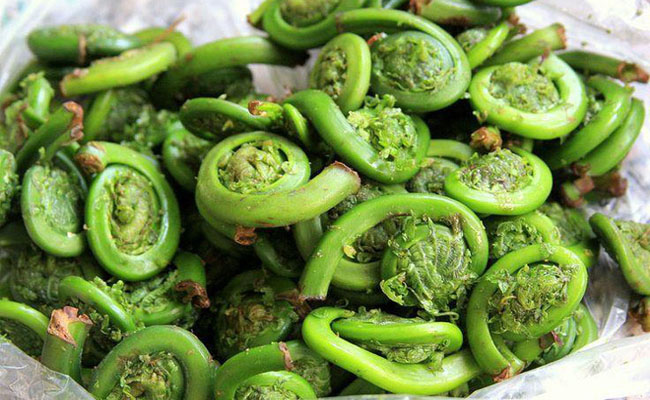Another luck of the woman who fell into the cliff in Yen Tu is the season of ferns growing but not eating this poisonous fern.
In a survival situation forced to search for food, the woman who fell into the Yen Tu abyss for 7 days survived except for the passion tree and the fern – but fortunately she did not eat this poisonous fern.
Nutritional value of ferns
Ms. NTBL (Hanoi) – a woman who fell into the cliff in Yen Tu for 7 days still survived thanks to the strong and fresh growth of ferns and peanuts on the mountain slopes, which is a great source of medicinal vegetables for her family. supply to the human body.
In Vietnam, the fern tree (also known as Thai december, cycad, grows a lot in wet places, along forests, stream banks, deep pools…) and is considered as a weed, not used to eat.

Ferns often grow in the mountainsides, wet places… in the north. Illustration.
According to Oriental medicine, the fern has a sweet, bitter taste, and is cold. Has the effect of clearing heat, laxative, hemostasis, phlegm, cold, cough, sore throat, weakened blood, cold, diarrhea, sprains, vitiligo, skin diseases, fatigue Knee, back pain, spermatorrhea, leukocytosis, urinary incontinence due to kidney failure, aching limbs, painful joints, difficulty moving… Or bleeding, spraining, chewing (crushing) leaves of bone slag applied to the wound the wound will heal quickly.
In the fern plant, there are proteins, fats, vitamins and minerals, which help replenish water and fiber which are very good for the body. Young and fresh fern leaves help to nourish the five organs, benefit meridians and tendons… But ferns must be combined with traditional medicines in each specific lesson, reducing the dosage, processing appropriately and flexibly. … new effective.
Ferns are grown in polluted areas because they help to quickly treat pollution and purify domestic water. Upstream ferns grow water to filter water, reduce arsenic content in the soil (capable of separating arsenic from domestic water to help reduce the risk of cancer, skin damage…).
According to Assoc. Prof. Dr. Nguyen Duy Thinh (former lecturer of the Institute of Food and Biotechnology), the woman fell into the Yen Tu cliff in misfortune but was very lucky.
It was that woman who had good survival skills to save herself, knew about the edible plants in the forest, and in due season ferns and elm trees grew to keep her alive.
Mr. Thinh said that the ferns and passionflowers that the woman who fell into the Yen Tu abyss ate for 7 days are non-toxic plants, although not rich in special nutrients, but have some nutrients that can be eaten to maintain health. life for a while.
If Mrs. L. does not understand plants well, it is likely that she will eat a poisonous fern, or a poisonous plant that can be life-threatening (for example, the same fern but eating a lot of hawk fern can cause harm. cancer, poisoning).

Not all ferns are edible. Illustration.
How to identify edible ferns
The fern grows in many countries, commonly found in Asia, northern China, Korea… the forests of Central Asia, Russia and Ukraine, Mexico… grows in deserts and swamps. Spring ferns are often harvested to make many delicious dishes in Japan, Korea, Russia..
But not all ferns are edible, according to the experience shared by some netizens, some poisonous ferns often have dark green foliage with red dots.
Edible ferns are slightly smaller in size than non-edible ferns – purely herbaceous, bright green in color. The edible part of the fern plant is the young hairy fern (called the violin head fern).
Edible ferns include the following varieties: Pteridium aquilinum, which grows in Siberia, the Far East, the Urals, Moscow; Common ostriches (Matteuccia struthiopteris) are common in central Russia and Osmunda Asia.
Fresh green violin-headed ferns are collected, 10-12cm long and tend to grow in clusters of 6, with a deep groove on the stem (quite similar to celery). They cut off / cut off the head, leaving the trunk to help the plant grow further.
The fern buds are harvested in early May – when the fern sprouts have just popped out of the ground and twisted like a snail. Then the young stem straightens, curls open, leaves appear on the tops – the best time to collect edible ferns is only about 3-5 days will be juicy, earlier not edible, harvested later then the plant develops into an adult fern, eating bitter, fibrous and chewy, reduced freshness, poor taste and inedible.
Accordingly, young curled ferns with a bright green color in shady or humid areas are broken (not cut) to a petiole length of 20 – 30 cm (5 cm above ground), the petioles should be of the same color and size – if there is a difference then double check.
After picking the fern, it must be straightened, placed under the canopy and watered (do not pile up because it will generate heat and spoil quickly). Edible fern does not last long, but its young shoots, when prepared properly, will surprise even the discerning gourmet with its taste, and its health benefits.

Fern dishes that are considered safe are eaten in moderation and must be cooked thoroughly. Illustration.
Fern dishes that are considered safe should be eaten in moderation, and thoroughly cooked. Concerns about some ferns containing ptaquiloside – a compound that causes stomach cancer is that the substance is easily eliminated because it can be dissolved in water, destroyed by boiling and exposed to water. salt.
In a survival situation, you have to eat it raw, if you can’t clean the substance, it’s not too much of a concern, because you have to eat a large amount of fern for a long time for the compound to have enough to work.
To eat ferns, it is necessary to know the origin of the place of planting, and must be grown in a place that is not polluted, there are no toxic chemicals harmful to humans. Countries that use ferns for food are thoroughly tested for safety and nutritional content.
Health authorities recommend boiling fern heads for 15 minutes, or steaming 10-12 minutes before eating. The elevated water temperature will neutralize any harmful elements in the vegetables, reduce the tannins and remove the bitterness from the fern.
Also do not use much fern for a long time because it is easy to cause abdominal distension, stuffy nose, blurred vision, decreased physiology, weakness in legs, possibly cancer.
In particular, the hawk fern – pteridium aquilinum has toxins that cause poisoning and cancer.
Note:
– Unable to distinguish between healthy ferns and poisonous ferns, they should not be eaten. If you must eat, use a maximum of 10g, do not eat much and eat for a long time.
– Eat fern buds that need to be cooked. Should not be eaten raw as there is a slight chance of poisoning.
If boiling is not possible to remove harmful pollutants, you can protect yourself by:
Soak the fern’s head to help dissolve the ptaquiloside, wash it a few times to prevent this carcinogen-like compound from growing.
– Anything harvested in the wild needs to be soaked in water, washed to limit direct contact with viruses and bacteria (reducing the risk of diarrhea, vomiting or stomach cramps…).
Ferns are both ornamental and filter toxic substances such as xylene, toluene, formic aldehydes in the air, have the ability to absorb arsenic toxins in the soil, clean water sources, and protect water from pollutants. . If you eat the whole plant, or the leaves of the fern, it will be harmful – especially the ferns that live in a toxic environment, the toxicity will be higher (such as ferns growing where arsenic is heavily contaminated will have many times higher levels of arsenic). ). So do not eat ferns of unknown origin because the risk of poisoning is very high. According to Dr. Dr. Ngo Quang Hai (Former Deputy Director of Center for Training and Directing) Central Hospital of Acupuncture, shared on VnExpress), |
at Blogtuan.info – Source: 24h.com.vn – Read the original article here



